NCERT Solutions Class 9 Maths
Chapter – 7 (Triangles)
The NCERT Solutions in English Language for Class 9 Mathematics Chapter – 7 Triangles Exercise 7.3 has been provided here to help the students in solving the questions from this exercise.
Chapter 7: Triangles
- NCERT Solution Class 9 Maths Ex – 7.1
- NCERT Solution Class 9 Maths Ex – 7.2
- NCERT Solution Class 9 Maths Ex – 7.4
- NCERT Solution Class 9 Maths Ex – 7.5
Exercise – 7.3
1. ΔABC and ΔDBC are two isosceles triangles on the same base BC, and vertices A and D are on the same side of BC (see Fig. 7.39). If AD is extended to intersect BC at P, show that
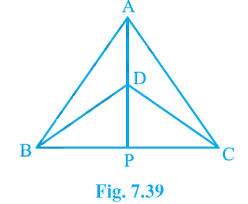
(i) ΔABD ≅ ΔACD
(ii) ΔABP ≅ ΔACP
(iii) AP bisects ∠A as well as ∠D
(iv) AP is the perpendicular bisector of BC
Answer – Given: Δ ABC and Δ DBC are isosceles triangles.
(i) ΔABD ≅ ΔACD
In ΔABD and ΔACD,
AB = AC (Equal sides of isosceles ΔABC)
BD = CD (Equal sides of isosceles ΔDBC)
AD = AD (Common)
ΔABD ≅ ΔACD (By SSS congruence rule)
By CPCT, we get
∠BAD = ∠CAD
∠BAP = ∠CAP ——————- (1)
∠ADB = ∠ADC ——————- (2)
(ii) ΔABP ≅ ΔACP
AB = AC (Given)
∠BAP = ∠CAP [From equation (1)]
AP = AP (Common)
∴ ΔABP ≅ ΔACP (By SAS congruence rule)
∴ BP = CP (By CPCT) ——————- (3)
(iii) AP bisects ∠A as well as ∠D
From Equation (1) we know that ∠BAP = ∠CAP
Hence, AP is the angle bisector of ∠A.
From equation (2), we know that ∠ADB = ∠ADC
⇒ 180° – ∠ADB = 180° – ∠ADC
⇒ ∠BDP = ∠CDP ——————- (4)
Hence, AP is the bisector of ∠D.
(iv) AP is the perpendicular bisector of BC
∠BPD = ∠CPD (by CPCT as ΔBPD ΔCPD)
BP = CP ———-— (5)
also,
∠BPD + ∠CPD = 180° (Since BC is a straight line)
⇒ 2 ∠BPD = 180°
⇒ ∠BPD = 90° ———-— (6)
Now, from equations (5) and (6), it can be said that
AP is the perpendicular bisector of BC.
2. AD is an altitude of an isosceles triangle ABC in which AB = AC. Show that
(i) AD bisects BC
(ii) AD bisects ∠A.
Answer – Given: AB = AC
Let’s construct an isosceles triangle ABC in which AB = AC as shown below.
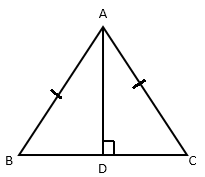
(i) AD bisects BC
In ΔBAD and ΔCAD,
∠ADB = ∠ADC (Each 90° as AD is an altitude)
AB = AC (Given)
AD = AD (Common)
∴ ΔBAD ≅ ΔCAD (By RHS Congruence rule)
∴ BD = CD (By CPCT)
Hence, AD bisects BC.
(ii) AD bisects ∠A
Since, ΔBAD ≅ ΔCAD
By CPCT, ∠BAD = ∠CAD
Hence, AD bisects ∠A.
3. Two sides AB and BC and median AM of one triangle ABC are respectively equal to sides PQ and QR and median PN of ΔPQR (see Fig. 7.40). Show that:
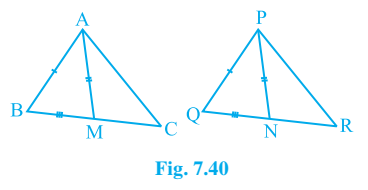
(i) ΔABM ≅ ΔPQN
(ii) ΔABC ≅ ΔPQR
Answer – Given: AB = PQ, AM = PN, BM = QN
(i) ΔABM ≅ ΔPQN
In ΔABC, AM is the median to BC.
∴ BM = BC
In ΔPQR, PN is the median to QR.
∴ QN = QR
It is given that BC = QR
∴ BC =
QR
∴ BM = QN —————— (1)
In ΔABM and ΔPQN,
AB = PQ (Given)
BM = QN [From equation (1)]
AM = PN (Given)
∴ ΔABM ≅ ΔPQN (Using SSS congruence criterion)
⇒ ∠ABM = ∠PQN (By CPCT)
⇒ ∠ABC = ∠PQR —————— (2)
(ii) ΔABC ≅ ΔPQR
In Δ ABC and Δ PQR,
AB = PQ (Given)
∠ABC = ∠PQR [From Equation (2)]
BC = QR (Given)
∴ ΔABC ≅ ΔPQR (By SAS congruence rule)
4. BE and CF are two equal altitudes of a triangle ABC. Using the R.H.S. congruence rule, prove that the triangle ABC is isosceles.
Answer – Let’s construct a diagram according to the given question as shown below.
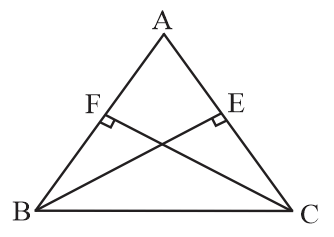
In ΔBEC and ΔCFB,
∠BEC = ∠CFB (Each 90°)
BC = CB (Common)
BE = CF (altitudes are equal given)
∴ ΔBEC ≅ ΔCFB (By RHS congruency)
∴ ∠BCE = ∠CBF (By CPCT)
∴ AB = AC (Sides opposite to equal angles of a triangle are equal)
Hence, ΔABC is isosceles.
5. ABC is an isosceles triangle with AB = AC. Draw AP ⊥ BC to show that ∠B = ∠C.
Answer – Let’s construct a diagram according to the given question.
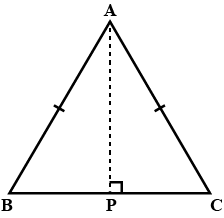
In triangles APB and APC,
∠APB = ∠APC (Each 90°)
AB = AC (Since ABC is an isosceles triangle)
AP = AP (Common)
ΔAPB ≅ ΔAPC (Using RHS congruence rule)
Thus, ∠B = ∠C (CPCT)

Leave a Reply